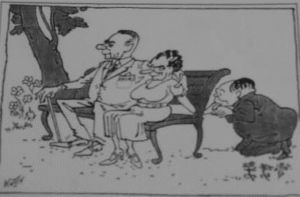Chapter – 1
The Cold War Era
In this post, we have given the Important Questions of Class 12 Political Science Chapter 1 (The Cold War Era) in English. These Important Questions are useful for the students who are going to appear in class 12 board exams.
| Board | CBSE Board, UP Board, JAC Board, Bihar Board, HBSE Board, UBSE Board, PSEB Board, RBSE Board |
| Textbook | NCERT |
| Class | Class 12 |
| Subject | Political Science |
| Chapter no. | Chapter 1 |
| Chapter Name | (The Cold War Era) |
| Category | Class 12 Political Science Important Questions in English |
| Medium | English |
Chapter 1 The Cold War Era
One Marker Questions
Q1. What is the full form of N.P.T and NATO
Ans. Non Proliferation Treaty. North Atlantic Treaty Organisation.
Q2. Name two members of the Axis Power.
Ans. Gemany. Japan
Q3. What is the full form of START ?
Ans. Strategic Arms Reduction Treaty signed between the USA and Soviet Union.
Q4. Correct and rewrite the statement given :The Soviet Union led Warsaw Pact troops invaded Poland in August 1968 to curb unrest.
Ans. The Soviet Union led Warsaw Pact troops invaded Czechoslovakia in August 1968 to curb unrest.
Q5. Which of the following is presently not a member of NATO : Albania, Denmark, Iceland, Slovenia, Turkey, Mexico?
Ans. Mexico.
Q6. India has signed a 20 year Treaty of Peace and Friendship with which country?
Ans. USSR/Russia.
Q7. Which was considered a ‘third option’ by Third World countries ?
Ans. NAM was considered a ‘third option’ by Third World countries
Q8. The First online summit of NAM was held in the year …………
Ans. 2020
Q9. Which of the following was not a member of SEATO ?
- U.S.S.R.
- New Zealand
- Pakistan
- Australia
Ans. A) USSR
Q10. The Military alliance formed by USSR was
- Warsaw Pact
- NATO
- NAM
- CENTO
Ans. Warsaw Pact
Two Marker Questions
Q1. Give two objectives of the Non Aligned Movement as envisaged by Jawaharlal Nehru.
Ans. India to take a firm stand on international issues, to enable India to balance one Superpower against the other and have friendly relations with both.
Q2. Why was the Warsaw pact also called the Eastern Alliance ?
Ans. The Warsaw pact was also called the Eastern Alliance due to the alliance of eastern European countries with the Soviet Union and most of them were situated in Eastern part of Europe.
Q3. What do you understand by the term Cold War ?
Ans. The cold war was an intense form of rivalry but it did not lead to an actual war of bloodshed and ‘face to face’ armed war.
Q4. What do you understand by the Non Aligned Movement ?
Ans. The Non Aligned Movement was formed during the cold war to keep distance from both the Superpowers supported military alliances.
Q5. Name the respective leader of the USA and USSR during the Cuban missile crisis.
Ans. John F. Kennedy and Nikita Khrushchev.
Four Marker Questions
Q1. Why did small nations join the military alliances made by the superpowers and what do you understand by, The bandwagon policy ?
Ans. The small nations benefited from the economic, military and political support given by the superpowers. The bandwagon policy means when a small state aligns with a stronger power and receives political, economic, military help against its local regional rival.
Q2. What were the treaties signed by the USA and USSR for arms control ? Explain in brief.
Ans. The Strategic Arms Limitation Treaty (SALT-I & II (1972, (1979) and the Anti-Ballistic Missile Treaty (1972) was the result of the SALT talks signed and heralded a new period of cooperation between the two superpowers. LTBT( 1963) banned nuclear testing in outer space and underwater. Both the superpowers agreed to limit the testing, production and deployment or use of nuclear weapons.
Q3. Explain the role played by India during the cold war ?
Ans. India played an important role in uniting countries which did not want to be part of the military alliances during the cold war. Under the leadership of Jawaharlal Nehru India raised its voice against newly independent Nations becoming part of the military blocs. India mediated between the two rival alliances and helped defuse tensions.
Q4. Why do you think that NAM has become irrelevant today ? Give reasons to support your answer.
Ans. NAM contains some core values and enduring ideas for promoting world peace, cooperation and mutual trust. It is based on a recognition that decolonised states or newly independent states of Asia, Africa and Latin America share a historical bond and can become a powerful force if they come together. The above core ideas are still relevant today. The most important role for NAM today lies in framing a concrete economic agenda for a just and fair international economic order. The WTO rules and procedures have failed to provide adequate economic gains to the Third World. Since its birth NAM has been playing a very active role in fostering cooperation among nations particularly among developing countries
Q5. What do you know about the Cuban missile Crisis ?
Ans. For thirteen days in October 1962 the world waited—seemingly on the brink of nuclear war—and hoped for a peaceful resolution to the Cuban Missile Crisis. In October 1962, an American U-2 spy plane secretly photographed nuclear missile sites being built by the Soviet Union on the island of Cuba.
Five Marker Questions
Q1. Study the Cartoon given above and answer the following :

1. Which two leaders of the countries are being depicted sitting on the bench?
Ans. The leaders of the two countries are USA and USSR
2. What is being shown through the cartoon ?
Ans. The cartoon depicts world political drama where China makes overtures to the USA. It reveals that the US aimed into a secret understanding with China keeping the USSR in the dark.
3. What did the USA do to improve its relations with China ?
Ans. President Richard M. Nixon arrived in China for an official trip. He was the first US President to visit the People’s Republic of China since it was established in 1949. This was an important event because the USA was seeking to improve its relations with the Communist country during the Cold War.
Six Marker Questions
Q1. Explain any four objectives of the Non-Aligned Movement.
Ans. To promote and encourage sustainable development through International cooperation, aimed at the end of colonization and freedom for all nations, to pmmote international peace and security, solving disputes through diplomatic talks and peaceful means, to prevent the newly independent nations of Asia and Africa joining Superpower led military alliances, advocating sovereign and equal relation among developed and developing nations, to strengthen the United Nations Organisation as an instrument of world peace and protection of human rights.
Q2. What led to the rise of the cold war ? Which incident is considered its high point ?
Ans. Western democracies have always been hostile to the idea of a communist state; the United States had refused recognition to the USSR for 16 years after the Bolshevik revolution (1917). The ideological conflict between the two Superpowers led to the emergence of nuclear weapons, the rivalry between USSR and USA The Cuban missile crisis of 1962 was a high point in the duration the cold war. Tensions increased when a U -2 plane was shot down by Soviet missile. It was the closest the world had ever come to an all-out nuclear war. The deployment of nuclear missiles in Cuba by Soviet Union in retaliation to American deployments of missiles in Italy and Turkey led to confrontation with the United States . It escalated into an international crisis. Nikita khrushchev had agreed to Cuba’s request to place nuclear missiles on the island to deter a future invasion like the Bay of Pigs (1961) by Cuban exiles supported by the USA.
Q3. Why has India refused to sign NPT ?
Ans. India has refused to sign NPT as it aims at non proliferation (stopping spread of nuclear weapons) selectively and is applicable only for the non -nuclear powers like India, Israel, South Sudan, Pakistan. It safeguards the monopoly of the existing five nuclear powers. India feels NPT is discriminatory. There is also no clause in it to further stop proliferation/increase of weapons by these five countries.They can acquire weapons but other countries cannot. India believes that there is a need for a total disarmament and safe destruction of nuclear weapons by all countries.
We hope that Class 12 Political Science Chapter 1 (The Cold War Era) Important Questions in English helped you. If you have any queries about class 12 Political Science Chapter 1 (The Cold War Era) Important Questions in English or about any other notes of class 12 Political Science in English, so you can comment below. We will reach you as soon as possible…



sir apne to iske answers upload hi nhi kiye hai!!